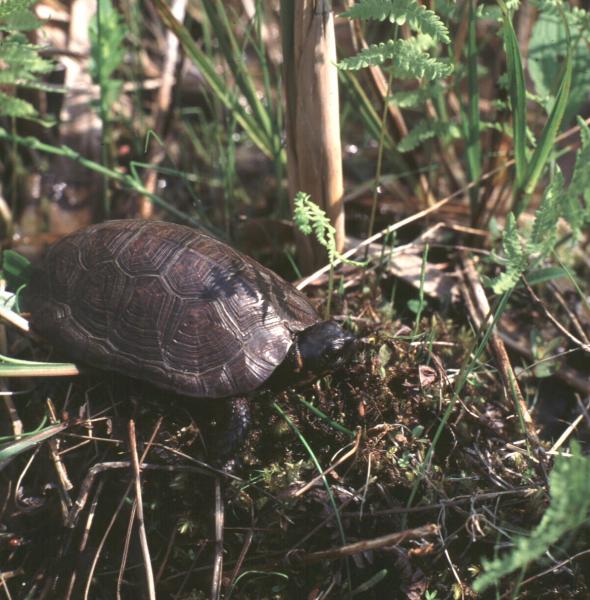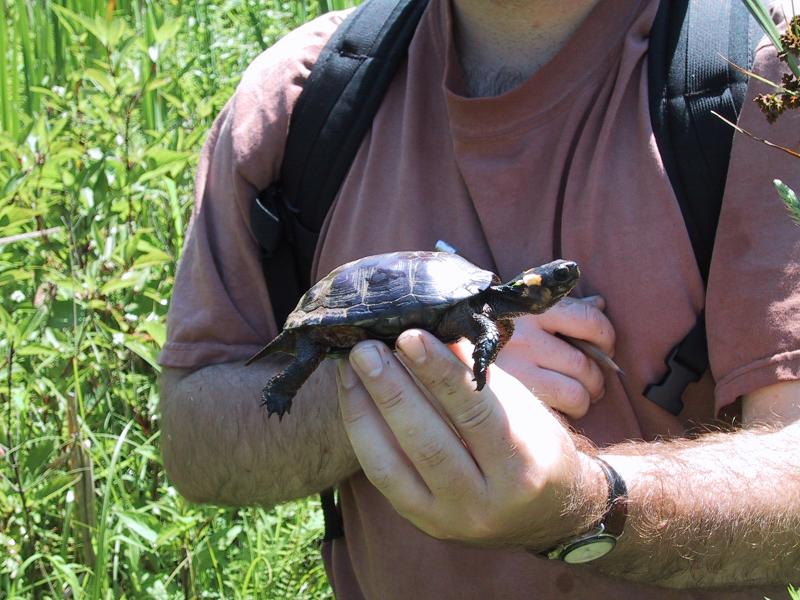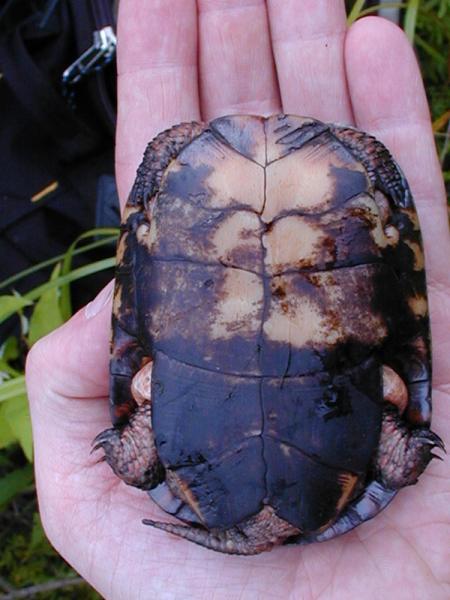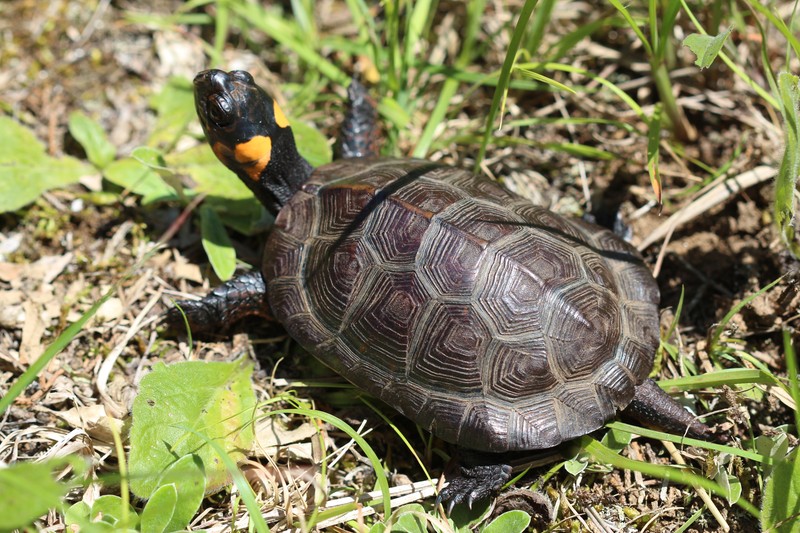Bog Turtle
Glyptemys muhlenbergii (Schoepff, 1801)
- Class
- Chelonia (Turtles)
- Family
- Emydidae (Box Turtles and Pond Turtles)
- State Protection
- Endangered
Listed as Endangered by New York State: in imminent danger of extirpation in New York. For animals, taking, importation, transportation, or possession is prohibited, except under license or permit. For plants, removal or damage without the consent of the landowner is prohibited.
- Federal Protection
- Threatened
Listed as Threatened under the Federal Endangered Species Act
- State Conservation Status Rank
- S2
Imperiled in New York - Very vulnerable to disappearing from New York due to rarity or other factors; typically 6 to 20 populations or locations in New York, very few individuals, very restricted range, few remaining acres (or miles of stream), and/or steep declines.
- Global Conservation Status Rank
- G2G3
Imperiled or Vulnerable globally - At high or moderate risk of extinction due to rarity or other factors; typically 80 or fewer populations or locations in the world, few individuals, restricted range, few remaining acres (or miles of stream), and/or recent and widespread declines. More information is needed to assign either G2 or G3.
Summary
Did you know?
The bog turtle is one of the smallest turtles in North America. Bog turtles in the northern part of the range are generally less than 100 millimeters (4 inches) in length, while turtles farther south reach sizes of up to 115 millimeters (4.5 inches) (USFWS 2001).
State Ranking Justification
Despite the apparently large number of populations, significant threats to these populations exist. Many of the populations contain few individuals and the habitats that support them are often small. While additional bog turtle sites will probably be discovered, most are likely to be part of existing metapopulations and be under some threat.
Short-term Trends
Survey efforts have recently been aimed at marking individual turtles at multiple sites to obtain population data and it is too early to determine short-term trends. The best populations are likely to contain fewer than 100 individuals and most are likely to have far fewer individuals. Thirteen populations have between 10 and 92 individuals documented from them and it is probable that an unknown number of additional turtles are also present. Far fewer individuals are known from the remaining populations. Five populations are known to be extirpated and it is likely that many of the populations with records from the 1970s or earlier are extirpated as well.
Conservation and Management
Threats
A spotty distribution and specialized habitat requirements make this species vulnerable to local extirpation. Declines are primarily due to loss, degradation, and fragmentation of habitat. Road mortality, an increase in subsidized predators, natural succession, and the expansion of invasive exotic vegetation are associated with these primary threats. Illegal collecting for the pet trade is also a direct threat to populations.
Conservation Strategies and Management Practices
The control of exotic species and natural succession is warranted at a number of sites. The control of subsidized predators may be desirable if predation of eggs and juveniles is unusually high.
Research Needs
Additional research on population size, intra-habitat use, and inter-habitat movements and migration is needed.
Habitat
Habitat
In New York, bog turtles occur in open-canopy wet meadows, sedge meadows, and calcareous fens. The known habitat in the Lake Plain region of the state includes large fens that may include various species of sedges, such as slender sedge (Carex lasiocarpa), bog buckbean (Menyanthes trifoliata), mosses (Sphagnum spp.), pitcher plants (Sarracenia sp.), scattered trees, and scattered shrubs. In the Hudson River Valley, bog turtle habitats may be isolated from other wetlands or they may exist as part of larger wetland complexes. These wetlands are often fed by groundwater and the vegetation always includes various species of sedges. Other vegetation that is frequently found in southern New York bog turtle sites includes shrubby cinquefoil (Potentilla fruticosa), grass-of-parnassus (Parnassia glauca), mosses (Sphagnum spp.), horsetail (Equisetum sp.), scattered trees such as red maple (Acer rubrum), red cedar (Juniperus virginianus), and tamarack (Larix laricina), and scattered shrubs such as willows (Salix spp.), dogwood (Cornus spp.), and alder (Alnus spp.).
Associated Ecological Communities
- Black spruce-tamarack bog*
(guide)
A conifer forest that occurs on acidic peatlands in cool, poorly drained depressions. The characteristic trees are black spruce and tamarack; in any one stand, either tree may be dominant, or they may be codominant. Canopy cover is quite variable, ranging from open canopy woodlands with as little as 20% cover of evenly spaced canopy trees to closed canopy forests with 80 to 90% cover.
- Dwarf shrub bog*
(guide)
A wetland usually fed by rainwater or mineral-poor groundwater and dominated by short, evergreen shrubs and peat mosses. The surface of the peatland is usually hummocky, with shrubs more common on the hummocks and peat moss throughout. The water in the bog is usually nutrient-poor and acidic.
- Marl fen
(guide)
A wetland that occurs on a bed of marl. Marl is a whitish substance that is deposited from water that has a lot of calcium dissolved in it. The whitish substance is calcium carbonate, people used to harvest marl to lime agricultural fields. The marl substrate is always saturated, may be flooded, and has a very high pH, generally greater than 7.5. The main source of water is always groundwater. The plants are often sparse and stunted. Marl fens may occur as small patches within a rich graminoid fen.
- Medium fen
(guide)
A wetland fed by water from springs and seeps. These waters are slightly acidic (pH values generally range from 4.5 to 6.5) and contain some dissolved minerals. Plant remains in these fens do not decompose rapidly and thus the plants in these fens usually grow on older, undecomposed plant parts of woody material, grasses, and mosses.
- Red maple-hardwood swamp
(guide)
A hardwood swamp that occurs in poorly drained depressions, usually on inorganic soils. Red maple is usually the most abundant canopy tree, but it can also be codominant with white, green, or black ash; white or slippery elm; yellow birch; and swamp white oak.
- Red maple-tamarack peat swamp
(guide)
A swamp that occurs on organic soils (peat or muck) in poorly drained depressions. These swamps are often spring fed or enriched by seepage of mineral-rich groundwater resulting in a stable water table and continually saturated soil. The dominant trees are red maple and tamarack. These species usually form an open canopy (50 to 70% cover) with numerous small openings dominated by shrubs or sedges.
- Rich graminoid fen
(guide)
A wetland of mostly grasses usually fed by water from highly calcareous springs or seepage. These waters have high concentrations of minerals and high pH values, generally from 6.0 to 7.8. Plant remains do not decompose rapidly and these grasses usually grow on older, undecomposed plant parts.
- Rich shrub fen
(guide)
A wetland with many shrubs that is usually fed by water from springs and seeps. These waters have high concentrations of minerals and high pH values, generally from 6.0 to 7.8. Plant remains in these fens do not decompose rapidly and thus the plants in these fens usually grow on older, undecomposed woody plant parts.
- Rich sloping fen
(guide)
A small, gently sloping wetland that occurs in a shallow depression on a slope composed of calcareous glacial deposits. Sloping fens are fed by small springs or groundwater seepage. Like other rich fens, their water sources have high concentrations of minerals and high pH values, generally from 6.0 to 7.8. They often have water flowing at the surface in small channels or rivulets.
- Sedge meadow
(guide)
A wet meadow community that has organic soils (muck or fibrous peat). Soils are permanently saturated and seasonally flooded. The dominant herbs must be members of the sedge family, typically of the genus Carex.
* probable association but not confirmed.
Associated Species
Range
New York State Distribution
Although historical records come from a larger area of the state, extant populations are known from small portions of six counties in the lower Hudson River Valley (Columbia, Dutchess, Putnam, Ulster, Orange, and Sullivan). There are a few records of bog turtles in Westchester County from the 1990s, but it is not known if any extant populations remain in this county. Extant bog turtle populations are also known from a small portion of Oswego County and single locations in Seneca County and Wayne County.
Global Distribution
The bog turtle occurs in twelve states in the United States and has a discontinuous distribution throughout its range. The northern portion of the range includes central and eastern New York, western Massachusetts, western Connecticut southward to Pennsylvania, New Jersey, Maryland, and northern Delaware. The southern part of the species range includes southeastern Virginia, western and central North Carolina, extreme western Tennessee, and western South Carolina and Georgia. There is a large hiatus of about 250 miles between the northern population and the southern population. Bog turtles occur from sea level to 4,200 feet in elevation in the Appalachians, although populations are usually found below 800 feet in the north. Bog turtles are believed to be extirpated in western Pennsylvania and in the Lake George region of New York.
Best Places to See
- Bog turtles are currently on display at Cold Spring Harbor Fish Hatchery and Aquarium in Cold Spring Harbor, New York (http://www.cshfha.org/) (Nassau County)
- As this species is vulnerable to illegal collection, no naturally occuring populations are listed.
- Bog turtles are currently on display at the Seneca Park Zoo in Rochester, New York (http://senecaparkzoo.org/). (Monroe County)
- Bog turtles are currently on display at the Rosamond Gifford Zoo at Burnet Park in Syracuse, New York (http://www.rosamondgiffordzoo.org/). (Onondaga County)
Identification Comments
Identifying Characteristics
This is a small turtle with adult carapace (upper shell) lengths ranging from 3 to 4.5 inches in length. The carapace is light brown to black, may have a faint yellowish or reddish pattern visible on the large scutes, and is strongly sculptured with growth lines visible, except in very old adults where the growth lines may be worn smooth. An inconspicuous keel is also present along the dorsal midline of the carapace. The plastron (lower shell) is mainly dark brown to black and may also have large yellowish or reddish blotches present. The head is black with two large orange or yellow blotches above and behind the tympanum (ear) on each side of the head.
Characters Most Useful for Identification
The small size and normally orange (sometimes yellow) head blotches are split into two parts and are characteristic of the species.
Diet
The diet of the bog turtle has been reported to include insects, plants, frogs, and carrion (Bury 1979). Fecal samples from Massachusetts have contained spiders (Aracnida), beetles (Coleoptera), millipedes (Diplopoda), flies (Diptera), snails (Gastropoda), ants (Hymenoptera), moths (Lepidoptera), dragonflies (Odonata), caddisflies (Trichoptera), and plant fragments (Klemens 1993). Slugs (Arion subflavus) have been reported as food items in southeastern New York, while slugs and crayfish have been reported as food items in North Carolina (USFWS 2001).
Best Time to See
Bog turtles are diurnal and are normally active during the early morning to mid-day hours, often in the direct sun. This species hibernates communally and shows site-fidelity to hibernacula.
- Present
- Reproducing
The time of year you would expect to find Bog Turtle present and reproducing in New York.
Similar Species
- Spotted Turtle (Clemmys guttata)
(guide)
Some individual spotted turtles may lack the characteristic yellow spots on their shells. This is rarely the case, however, and this species can always be distinguished from bog turtles by the many yellow spots that are present on their heads and necks (Conant and Collins 1998).
Bog Turtle Images
Taxonomy
Bog Turtle
Glyptemys muhlenbergii (Schoepff, 1801)
- Kingdom Animalia
- Phylum Craniata
- Class Chelonia
(Turtles)
- Order Testudines
(Turtles)
- Family Emydidae (Box Turtles and Pond Turtles)
- Order Testudines
(Turtles)
- Class Chelonia
(Turtles)
- Phylum Craniata
Synonyms
- Clemmys muhlenbergii (Schoepff, 1801)
Additional Resources
References
Arndt, R.G. 1980. The bog turtle- an endangered species? Pp. 99-107. in: P. Wray (ed). Proceedings of the northeast endangered species conference, Provincetown. 170 pp.
Behler, J. L., and F. W. King. 1979. The Audubon Society field guide to North American reptiles and amphibians. Alfred A. Knopf, New York. 719 pp.
Bickham, J. W., T. Lamb, P. Minx, and J. C. Patton. 1996. Molecular systematics of the genus Clemmys and the intergeneric relationships of emydid turtles. Herpetologica 52:89-97.
Bury, R. B. 1979. Review of the ecology and conservation of the bog turtle, CLEMMYS MUHLENBERGII. USFWS Spec. Sci. Rep.--Wildl. 219:1-9.
Carter, S. L., C. A. Haas, and J. C. Mitchell. 1999. Home range and habitat selection of bog turtles in southwestern Virginia. Journal of Wildlife Management 63:853-860.
Carter, S. L., C. A. Haas, and J. C. Mitchell. 2000. Movements and activity of bog turtles (Clemmys muhlenbergii) in southwestern Virginia. Journal of Herpetology 34:75-80.
Chambers, R.E. 1983. Integrating timber and wildlife management. State University of New York, College of Environmental Science and Forestry and New York State Department of Environmental Conservation.
Chase, J. D., et al. 1989. Habitat characteristics, population size, and home range of the bog turtle, Clemmys muhlenbergii, in Maryland. J. Herpetol. 23:356-362.
Collins, D. E. 1990. Western New York bog turtles: relicts of ephemeral islands or simply elusive? Pages 151-153 in Mitchell et al., eds. Ecosystem management: rare species and significant habitats. New York State Mus. Bull. 471.
Conant, R., and J. T. Collins. 1998. A field guide to reptiles and amphibians: eastern and central North America. Third edition, expanded. Houghton Mifflin Co., Boston, Massachusetts. 616 pp.
DeGraaf, R. M., and D. D. Rudis. 1983a. Amphibians and reptiles of New England. Habitats and natural history. Univ. Massachusetts Press. vii + 83 pp.
DeGraaf, R.M. and D.D. Rudis. 1981. Forest habitat for reptiles and amphibians of the northeast. United States Department of Agriculture, Forest Service Eastern Region, Milwaukee, WI. 239 pp.
Eckler, J. T., A. R. Breisch, and J. L. Behler. 1990. Radio telemetry techniques applied to the bog turtle (CLEMMYS MUHLENBERGII Schoepff 1801). Pages 69-71 in Mitchell et al., eds. Ecosystem management: rare species and significant habitats. New York State Mus. Bull. 471.
Ernst, C. H., R. T. Zappalorti, and J. E. Lovich. 1989. Overwintering sites and thermal relations of hibernating bog turtles, CLEMMYS MUHLENBERGII. Copeia 1989:761-764.
Ernst, C. H., and R. B. Bury. 1977. Clemmys muhlenbergii. Cat. Am. Amph. Rep. 204.1-204.2.
Ernst, C. H., and R. W. Barbour. 1972. Turtles of the United States. Univ. Press of Kentucky, Lexington. x + 347 pp.
Ernst, C. H., and R. W. Barbour. 1989a. Turtles of the world. Smithsonian Institution Press, Washington, D.C. xii + 313 pp.
Herman, D. W., and K. M. Fahey. 1992. Seasonal activity and movements of bog turtles (CLEMMYS MUHLENBERGII) in North Carolina. Copeia 1992:1107-1111.
Herman, D.W. 1981. Status of the bog turtle in the southern Appalachians. pp. 77-80. In R.R. Odom and J.W. Guthrie (eds.). Proceedings of the nongame and endangered wildlife symposium. GA Dept. of Nat. Res., Tech. Bull. WL5, 179 pp.
Holman, J. A., and U. Fritz. 2001. A new emydine species from the Medial Miocene (Barstovian) of Nebraska, USA with a new generic arrangement for the species of Clemmys sensu McDowell (1964) (Reptilia:Testudines:Emydidae). Zoologische Abhandlungen Staatliches Museum fur Tierkunde Dresden 51(19):321-344.
Kiviat, E. 1978. Bog turtle habitat ecology. Bulletin of the Chicago Herpetological Society. 13(2):29-42.
Klemens, M. W. 1993. Amphibians and reptiles of Connecticut and adjacent regions. State Geological and Natural History Survey of Connecticut, Bulletin 112. xii + 318 pp.
Landry, J.L. 1979. A bibliography of the bog turtle, Clemmys muhlenbergii (biology, ecology and distribution). Smithsonian Herpetological Information Service, no. 44:1-21.
Lovich, J. E., C. H. Ernst, R. T. Zappalorti, and D. W. Herman. 1998. Geographic variation in growth and sexual size dimorphism of bog turtles (Clemmys muhlenbergii). American Midland Naturalist 139:69-78.
Lovich, J. E., et al. 1991. Relationships among turtles of the genus Clemmys (Reptilia, Testudines, Emydidae) as suggested by plastron scute morphology. Zoologica Scripta 20:425-429.
McDowell, S. B. 1964. Partition of the genus Clemmys and related problems in the taxonomy of the aquatic testudinidae. Proc. Zool. Soc. London 143:239-279.
Merkle, D. A. 1975. A taxonomic analysis of the Clemmys complex (Reptilia: Testudines) utilizing starch gel electrophoresis. Herpetologica 31:162-166.
Mitchell, J. C. 1991. Amphibians and reptiles. Pages 411-76 in K. Terwilliger (coordinator). Virginia's Endangered Species: Proceedings of a Symposium. McDonald and Woodward Publishing Company, Blacksburg, Virginia.
Morrow, J. L., J. H. Howard, S. A. Smith, and D. K. Poppel. 2001a. Home range and movements of the bog turtle (Clemmys muhlenbergii) in Maryland. Journal of Herpetology 35:68-73.
Morrow, J. L., J. H. Howard, S. A. Smith, and D. K. Poppel. 2001b. Habitat selection and habitat use of the bog turtle (Clemmys muhlenbergii) in Maryland. Journal of Herpetology 35:545-552.
New York Natural Heritage Program. 2024. New York Natural Heritage Program Databases. Albany, NY.
New York Natural Heritage Program. New York State Department of Environmental Conservation. 625 Broadway, 5th floor. Albany, NY 12233-4757. (518) 402-8935.
New York State Department of Environmental Conservation. 1985. Checklist of the amphibians, reptiles, birds, and mammals of New York State, including their protective status. Nongame Unit. Wildlife Resources Center. Delmar, NY.
Reilly, E.M., Jr. 1958. Turtles of New York. New York State Conservationist.
Shoemaker, K. T., A. R. Breisch, J. W. Jaycox, and J. P. Gibbs. 2013. Reexamining the minimum viable population concept for long-lived species. Conservation Biology 3(27):542-551.
U.S. Fish and Wildlife Service (USFWS). 2000. Bog turtle (Clemmys muhlenbergii), northern population, recovery plan, agency draft. Hadley, Massachusetts. viii + 90 pp.
U.S. Fish and Wildlife Service (USFWS). 29 January 1997. Proposed rule to list the northern population of the bog turtle as threatened and the southern population as threatened due to similarity of appearance. Federal Register 62(19):4229-4239.
U.S. Fish and Wildlife Service (USFWS). 4 November 1997. Final rule to list the northern population of the bog turtle as threatened and the southern population as threatened due to similarity of appearance. Federal Register 62(213):59605-59623.
United States Fish and Wildlife Service. 2001. Bog turtle (Clemmys muhlenbergii), northern population, recovery plan. Hadley, Massachusetts. 103 pp.
Links
About This Guide
This guide was authored by: Jesse Jaycox
Information for this guide was last updated on: June 28, 2019
Please cite this page as:
New York Natural Heritage Program. 2024.
Online Conservation Guide for
Glyptemys muhlenbergii.
Available from: https://guides.nynhp.org/bog-turtle/.
Accessed July 26, 2024.



